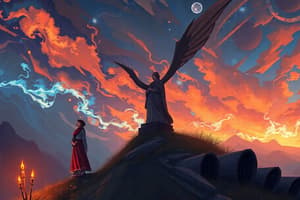Podcast
Questions and Answers
Which of these options is NOT a type of conflict in literature?
Which of these options is NOT a type of conflict in literature?
- Character vs. Society
- Character vs. Nature
- Character vs. Technology (correct)
- Character vs. Character
In a Character vs. Nature conflict, the protagonist always triumphs over nature.
In a Character vs. Nature conflict, the protagonist always triumphs over nature.
False (B)
What is the purpose of the inciting moment in a story?
What is the purpose of the inciting moment in a story?
The inciting moment introduces the main problem or conflict that drives the plot forward.
The climax of a story is the ______ point of the story.
The climax of a story is the ______ point of the story.
Match the following elements of plot structure with their descriptions:
Match the following elements of plot structure with their descriptions:
Which of these is an example of situational irony?
Which of these is an example of situational irony?
Sarcasm is a form of verbal irony.
Sarcasm is a form of verbal irony.
What is the purpose of the introduction paragraph in an essay?
What is the purpose of the introduction paragraph in an essay?
In a body paragraph of an essay, the ______ sentence states the main point of the paragraph.
In a body paragraph of an essay, the ______ sentence states the main point of the paragraph.
Which of these is NOT a transition word for ending paragraphs?
Which of these is NOT a transition word for ending paragraphs?
Which literary device involves a comparison using 'like' or 'as'?
Which literary device involves a comparison using 'like' or 'as'?
The protagonist is always the 'bad guy' in a story.
The protagonist is always the 'bad guy' in a story.
What is the literary term for the 'main idea or moral of the story'?
What is the literary term for the 'main idea or moral of the story'?
A(n) _________ is a reference to a historical person, place, or event.
A(n) _________ is a reference to a historical person, place, or event.
Match the following terms with their definitions:
Match the following terms with their definitions:
What type of conflict involves a character's internal struggle with their own emotions or beliefs?
What type of conflict involves a character's internal struggle with their own emotions or beliefs?
What is the term for when an author creates a surprising ending that the reader did not expect?
What is the term for when an author creates a surprising ending that the reader did not expect?
The author's attitude toward the subject is referred to as the story's ___________.
The author's attitude toward the subject is referred to as the story's ___________.
Flashcards
Protagonist
Protagonist
The main character of a story, often the one making key decisions and driving the plot forward.
Antagonist
Antagonist
The character who opposes the protagonist, often creating conflict and challenges.
Pathos
Pathos
A literary device used to evoke feelings of sadness, pity, or compassion in the reader, often focusing on the struggles of a character.
Foreshadowing
Foreshadowing
Signup and view all the flashcards
Theme
Theme
Signup and view all the flashcards
Symbol
Symbol
Signup and view all the flashcards
Internal Conflict: Character vs. Self
Internal Conflict: Character vs. Self
Signup and view all the flashcards
External Conflict: Character vs. Character
External Conflict: Character vs. Character
Signup and view all the flashcards
Character vs. Nature
Character vs. Nature
Signup and view all the flashcards
Character vs. Society
Character vs. Society
Signup and view all the flashcards
Character vs. Supernatural
Character vs. Supernatural
Signup and view all the flashcards
Situational Irony
Situational Irony
Signup and view all the flashcards
Verbal Irony
Verbal Irony
Signup and view all the flashcards
Exposition
Exposition
Signup and view all the flashcards
Inciting Moment
Inciting Moment
Signup and view all the flashcards
Rising Action
Rising Action
Signup and view all the flashcards
Climax
Climax
Signup and view all the flashcards
Falling Action/Denouement
Falling Action/Denouement
Signup and view all the flashcards
Study Notes
Short Story Analysis
- Protagonist: Main character, driving plot with key decisions.
- Antagonist: Story's "villain," opposing the protagonist.
- Pathos: Literary device evoking sadness, pity, compassion, or sympathy.
- Foreshadowing: Deliberate clues hinting at future events.
- Theme: Central idea or moral of the story.
- Symbol: Represents another idea/object; can be an abstract concept or concrete item.
- Ironic Twist: Shocking ending, opposite of reader's expectation.
- Tone: Author's attitude toward the story's subject.
- Mood: Reader's emotional reaction to the story.
- Metaphor: Comparison between unrelated things (e.g., "heart of gold").
- Simile: Comparison using "like" or "as" (e.g., "blind as a bat").
- Hyperbole: Exaggeration for effect (e.g., "I'm so hungry I could eat a horse").
- Alliteration: Repetition of consonant sounds (e.g., "busy as a bee").
- Allusion: Reference to person, place, or event from history (e.g., “Achilles Heel”).
Conflict Types
- Internal Conflict: Character vs. self (emotions, desires, beliefs, fears).
- External Conflict:
- Character vs. Character: Struggle between characters.
- Character vs. Nature: Conflict with natural forces (weather, disaster).
- Character vs. Society: Character struggles against unjust society.
- Character vs. Supernatural: Conflict with magical/otherworldly forces.
Irony Types
- Situational Irony: Event opposite of what's expected.
- Verbal Irony: Character says opposite of what's meant.
- Sarcasm: A type of verbal irony.
Plot Structure
- Exposition: Introduction of characters, conflict, setting, background.
- Inciting Incident: Event triggering the main plot.
- Rising Action: Events leading to the climax, building suspense.
- Climax: Point of highest tension, resolving central conflict.
- Falling Action/Denouement: Events leading to resolution.
- Resolution: Conclusion, tying up loose ends. (Can be brief/absent in ironic twists)
Opinion Essay Structure
Introduction
- Paragraph 1: Your opinion, three supporting reasons (in order of importance/strength).
Body Paragraphs (2, 3, 4)
- Format:
- Topic Sentence: State your reason.
- Supporting Detail 1: Two reasons with example.
- Supporting Detail 2: Two reasons with examples.
- Concluding Sentence: Briefly summarize your reason.
Conclusion
- Paragraph 5: Restate your opinion in different words.
- Ending thought or provoking statement.
Transition Words
- Beginning: First, firstly, starting off, to begin.
- End: To conclude, ultimately, consequently, as a whole, therefore, in essence.
- Contrast/Difference: Nevertheless, on the other hand, differing from, alternatively, conversely, despite.
- Similarity/Comparison: Equally, likewise, not to mention, correspondingly, in similar fashion, in fact.
Studying That Suits You
Use AI to generate personalized quizzes and flashcards to suit your learning preferences.




